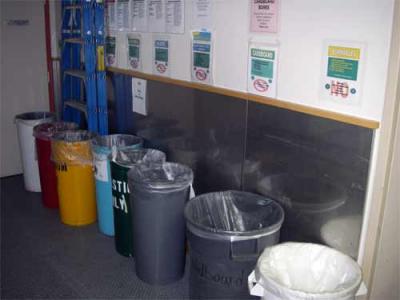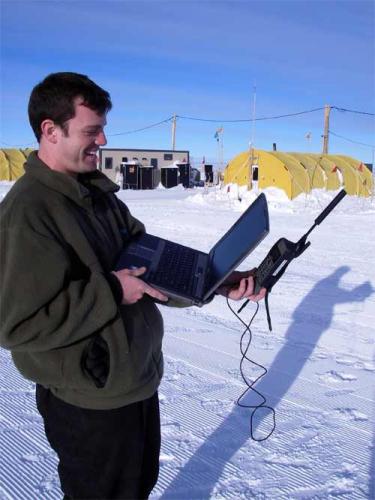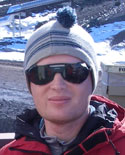Location: WAIS Divide
Life at WAIS is really quite nice! Very laid back, easy going, and people still get work done. Why can’t every day at work be like that? We haven’t been able to do much setup today because all of our stuff is packed on pallets and weighs nearly 1,000 pounds. We’re waiting for the fork lift to help out but they are waiting for the next two rounds of cargo flights to come in. Those flights are waiting to the weather to clear. We are watching what appears to be a major storm move into the area. We have UNCONFIRMED reports that this is one of the lowest pressure drops that they’ve seen here in some time. Some time could mean a variety of things, but as of now these are just rumors floating around. We’ll give you more updates as they become available. We have to say we’re kind of excited about weathering a true Antarctic storm, at least for now.
So, since there isn’t much new to report, let’s take some time to learn a little bit about life here at WAIS. WAIS Divide is located at an elevation of 5,919 ft, 885 miles from McMurdo, 700 miles from South Pole, and 350 miles from the coast. Needless to say, we’re in the middle of nowhere, and that might be an understatement. Temperatures have been consistently in the -10s C and have dropped as low as -27 C last ‘night’. Temperatures before we left McMurdo were warmer than back in Kansas! It now feels like Antarctica!
We have a series of outhouses and pee flags. We’ve mentioned pee flags before, and the purpose of them is to minimize the area used for waste collection. If everyone goes to the bathroom in the same place, we’re minimizing our effects on the environment. Keeping the environment in mind, we do the same kind of trash sorting as in McMurdo. Everything leaves this field camp, heads back to McMurdo, and is then flown back to the states.
Trash bins
 Trash bins at McMurdo. We have the same setup here at WAIS.
Trash bins at McMurdo. We have the same setup here at WAIS.
There are more modern facilities for hygiene; however, they all involve work on the part of the user. There are two showers here but you have to shovel AT LEAST one 32-gallon bucket of snow to replace the water used during the shower. There is a valve in the shower to turn off the water when you’re getting lathered up. Then you rinse. There are also washers and dryers. To do one load of laundry you have to shovel AT LEAST three 32-gallon buckets of snow! We’re not roughing it by any means, but these conditions are certainly more primitive than life in McMurdo.
We also have work shifts here. There is 11 full-time staff here, but that isn’t quite enough. We all have daily chores that need done around here. Every other day each person has house mouse duty during one of the meals. This entails shoveling snow to be melted for drinking water, cleaning up the galley, washing dishes, etc; all the work necessary to keep the camp clean and in good order. This is all very important to climate of the camp. We obviously have Internet access, via satellite, however it is quite slow, and we only have satellite coverage for five hours a day.
First Satellite Attempt
 Brandon attempts to use the Iridium satellite phone to check email. He eventually found a signal inside a building.*
Brandon attempts to use the Iridium satellite phone to check email. He eventually found a signal inside a building.*
Knut Christianson

BIOGRAPHY: Knut has always been interested in meteorology, specifically winter weather, but became involved in glaciology through an undergraduate research program at St. Olaf College which specialized in using ground-penetrating radar to examine the Antarctic Ice Sheet, the Greenland Ice Sheet, and glaciers in Sweden, Alaska, and the western United States. While an undergraduate Knut studied physics and mathematics which were also his best subjects in high school. He became involved in glaciology research while looking for a summer job where he could earn some money and also do something to further his physics education. At the time Knut was sophomore physics major in college and unsure of what he wanted to do after graduating. He was pursuing a physics degree in order to get a solid background in science and mathematics that would be applicable in a variety of fields. After a year of working in the glaciology group at St. Olaf he decided to pursue glaciology as a career. He became further involved in glaciology research in while living in Norway through working with the Norwegian Polar Institute and participating in 3 field seasons in Svalbard (approx. 80N latitude).
"For those interested in being a scientist I would recommend getting a solid basis in physics, mathematics, chemistry and biology while in high school and expanding on those skills in college. Computer science also plays an increasingly valuable role in science and good knowledge of computer use and some knowledge of programming are necessary skills if you wish to pursue a career as a scientist.”

